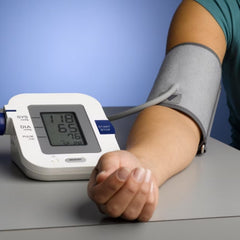Warning Signs of Blood Clots During Sleep: Don't Ignore These Symptoms
Table of Contents:
Blood clots are hidden dangers lurking silently within the body, posing a serious threat to our health. Many people may not realize that while we are peacefully asleep at night, the body may be sending out subtle signals indicating a potential risk of thrombosis.

Sudden Shortness of Breath or Waking Up Gasping for Air
Waking up in the middle of the night unable to breathe or gasping for air may be a sign of pulmonary embolism. When a blood clot forms in the deep veins of the legs and breaks loose, it can travel through the bloodstream to the lungs, blocking the pulmonary artery and disrupting lung circulation. As a result, the lungs can no longer exchange gases properly, causing the patient to suddenly feel breathless, sometimes even waking up in a panic.
Common Misunderstanding:
Many people mistake this symptom for a common respiratory issue or poor sleep quality, unaware that it could be a warning sign of pulmonary embolism. They may simply change their sleeping posture or take sleeping aids, instead of seeking medical attention, thereby missing the optimal treatment window.
Potential Danger:
Pulmonary embolism is extremely dangerous and, if left untreated, has a high mortality rate. It can lead to oxygen deprivation and tissue necrosis in the lungs, impairing respiratory and cardiac functions. Symptoms may include severe shortness of breath, chest pain, and coughing up blood, with the risk of sudden shock or even death.
Numbness in Hands or Feet Upon Waking
During sleep, the body remains relatively still, slowing down blood circulation. If a clot forms in a blood vessel, it can obstruct normal blood flow, especially to the extremities, causing numbness. This is more common in individuals with underlying conditions such as hypertension, hyperlipidemia, or diabetes, as their blood vessels are more prone to damage and clot formation.
Additionally, maintaining the same sleeping position for too long can compress the blood vessels in the arms or legs, leading to temporary numbness. However, numbness caused by poor circulation typically resolves quickly after movement, while numbness due to thrombosis tends to last longer and recur frequently.
Common Misunderstanding:
Many people attribute morning numbness to poor sleeping posture or fatigue and overlook the possibility of a blood clot. They may think the issue is resolved once the numbness fades, not realizing it could be a warning signal. Temporary relief does not mean the problem is gone—if left unchecked, the clot may worsen and lead to more serious complications.
Potential Danger:
If numbness is caused by a blood clot, it indicates prolonged ischemia in the affected area, potentially impairing nerve and muscle function. Over time, this can lead to weakness, muscle atrophy, and reduced quality of life. More alarmingly, if the clot dislodges and travels to vital organs such as the heart or brain, it can trigger life-threatening conditions like heart attacks or strokes.
Night Sweats
The presence of blood clots can disrupt blood circulation and metabolism, affecting the body’s temperature regulation mechanisms. As a result, the body may produce excessive sweat during sleep to dissipate heat. While night sweats can also be caused by other conditions such as tuberculosis or hormonal imbalances, the underlying causes and treatments vary.
Common Misunderstanding:
Many people assume night sweats are a sign of general weakness and try to remedy the issue with dietary supplements or traditional remedies. However, if the sweating is due to thrombosis, such methods won’t address the root cause. Delaying proper diagnosis and treatment of a clot can result in worsening health outcomes.
Potential Danger:
Persistent night sweats may lead to dehydration and electrolyte imbalances, disrupting the body's normal physiological functions. In some cases, night sweats may signal that a clot is growing or the condition is worsening, posing a serious threat if left untreated.
Frequent Leg Cramps at Night
Blood clots can alter the blood flow in the legs. When a clot blocks a vein, it hinders the return of blood, leading to local ischemia and oxygen deprivation, which can trigger muscle spasms and cramping. While deficiencies in calcium or magnesium may also cause cramps, clot-related cramps are typically more painful, frequent, and irregular, especially during the night.
Common Misunderstanding:
People often assume nighttime leg cramps are caused by calcium deficiency and self-medicate with supplements. However, calcium alone may not help if the underlying issue is thrombosis. Without identifying and addressing the real cause, treatment may be delayed and the condition may worsen.
Potential Danger:
Frequent cramps can severely impact sleep quality, leading to fatigue and low energy. Chronic cramping may damage muscle tissue and impair leg function. Moreover, a lingering clot increases the risk of pulmonary embolism—if the clot breaks off and travels to the lungs, it can cause severe symptoms like breathlessness and chest pain, potentially becoming life-threatening.
How to Prevent Blood Clots
To reduce the risk and progression of thrombosis, consider the following lifestyle practices:
- Maintain proper sleep posture and habits: Avoid staying in one position for too long, choose an appropriate pillow height, and develop healthy sleeping routines to reduce clot risk.
- Adopt a healthy lifestyle: Eat a balanced diet with less fat, salt, and sugar, and increase intake of fresh fruits, vegetables, and dietary fiber. Engage in moderate exercise such as walking, jogging, or swimming to improve circulation and lower blood viscosity. Avoid smoking, limit alcohol, don’t stay up late, and manage stress to protect vascular health.
- Get regular checkups: High-risk groups—including the elderly, bedridden individuals, those with obesity, and people with cardiovascular diseases—should undergo regular medical evaluations to detect and address potential health issues early.
- Seek medical help promptly: If you experience any of the warning signs mentioned above or other unusual symptoms during sleep, consult a doctor immediately. Medical professionals can tailor a treatment plan based on your condition to relieve symptoms, prevent complications, and improve your quality of life.
FAQs about Blood Clots
Are Blood Clots in Legs Dangerous?
Yes, blood clots in the legs can be dangerous. A clot in a leg vein may cause pain, warmth, and tenderness in the affected area. This condition is known as deep vein thrombosis (DVT), which can develop if you have certain medical conditions that affect how your blood clots. If left untreated, the clot can break loose and travel to the lungs, causing a life-threatening pulmonary embolism.
Are Blood Clots in the Lungs Dangerous?
Yes, blood clots in the lungs, known as pulmonary emboli (PE), are dangerous because they block blood flow to the lungs. This can severely reduce oxygen levels in the body and strain the heart. If not treated quickly, a pulmonary embolism can be life-threatening.
Are Blood Clots in the Neck Dangerous?
Yes, blood clots in the neck, particularly in the jugular veins or carotid arteries, can be dangerous and potentially life-threatening. These clots can restrict blood flow to the brain, increasing the risk of stroke, or they may travel to other vital organs, leading to serious complications.
Can A Bad Bruise Cause A Blood Clot?
A bad bruise results from damage to small blood vessels, and blood will naturally clot at the site to stop the bleeding, which forms the bruise. However, bruises themselves do not cause harmful blood clots. In cases of severe trauma, bruises, hematomas, and blood clots may all occur, but they typically form independently of one another.
Can A Blood Clot Cause Swelling?
Yes, a blood clot can cause swelling. When a clot forms in a vein, especially in the legs, it can block normal blood flow. This blockage leads to a buildup of pressure and fluid in the affected area, resulting in noticeable swelling. This is a common symptom of deep vein thrombosis (DVT), a potentially serious condition that requires medical attention.
Related Recommendations:
- Differentiating Between Benign Paroxysmal Positional Vertigo (BPPV) and Vertigo: Preventing Cardiovascular and Cerebrovascular Diseases
- How to Prevent and Reduce Plaque in Blood Vessels
- High Blood Lipids Warning: How to Identify Health Risks through Leg Symptoms
- These Small Things Can Affect Your Blood Sugar – Pay Attention!
- Can Calcium Supplements Lead to Vascular Calcification? How to Supplement Calcium Correctly





